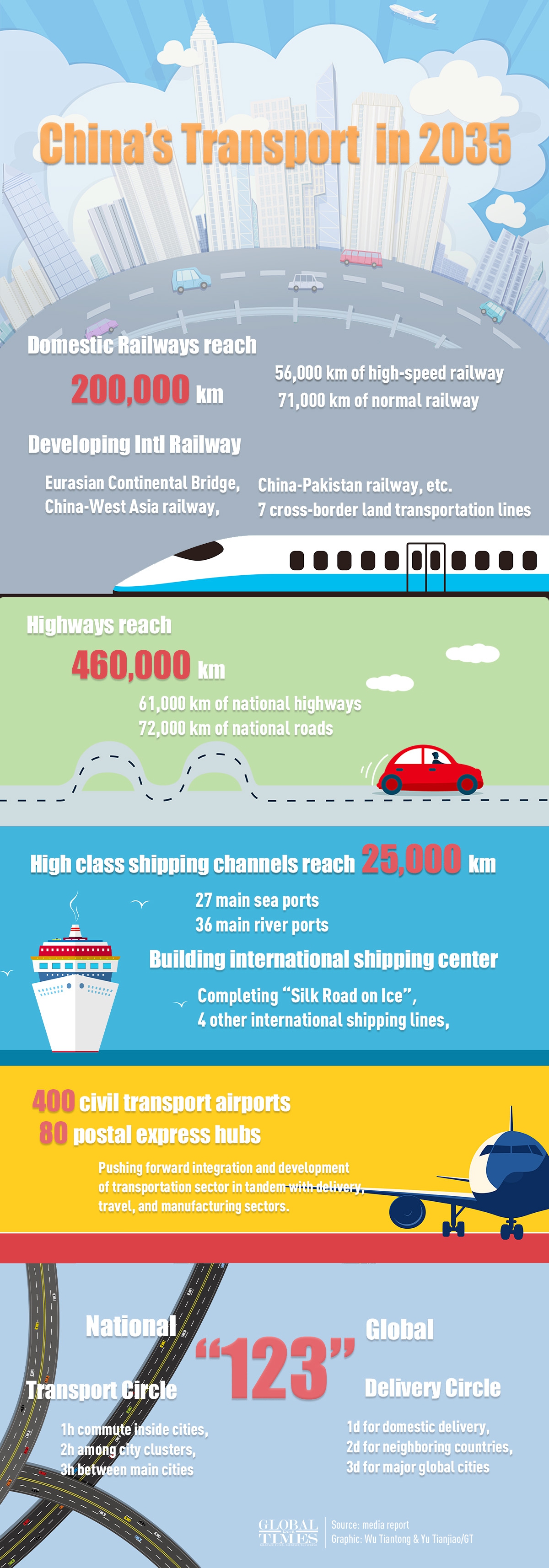China plans mega transport network to boost trade, economic growth
Global Times | 25 February 2021
China plans mega transport network to boost trade, economic growth
By Li Xuanmin
China’s plan to build a global rapid logistics circle for goods by 2035, which would allow goods to be delivered to neighboring countries and major international cities within two- three days, will likely boost China’s trade with major economies in the EU and Asia, observers said.
Some expect the country’s foreign trade to grow more than 5 percent annually during the 14th Five-Year Plan period (2021-25), and analysts said the broad plan is also significant in terms of coordinating a global industry chain where China plays a centralized and pivotal role. Riding on such momentum, the world’s economic center of gravity could gradually shift to China, they predicted.
According to a plan jointly issued by the Central Committee of the Communist Party of China and the State Council, China’s cabinet, on China’s comprehensive transportation network layout, the country aims to build 200,000 kilometers of railways, 460,000 kilometers of highways, and 25,000 kilometers of high-level sea lanes by 2035.
The total transportation network will reach 700,000 kilometers by 2035, according to the plan, with 27 major coastal ports, 400 civil transportation airports and 80 express hubs.
That will provide support for the "global 123" fast logistics circle for goods, which stands for one-day delivery in domestic market, two-day delivery for neighboring countries and three-day delivery for major global cities, the plan noted.
The unprecedented blueprint would create the world’s largest transportation network. Analysts said that as the plan will significantly shorten shipping times, it will facilitate China’s goods flow with other major economies — in particular with Asian countries with which China shares a land border, and countries along China’s southwest passage such as Pakistan, Myanmar and European nations.
At the end of 2020, the EU completed negotiations for a bilateral investment treaty with China, the bloc’s largest trading partner. Also, China in November signed the world’s largest trade deal, the Regional Comprehensive Economic Partnership (RCEP), that encompasses one- third of the global economy. Analysts said that improved logistics connectivity could speed up those trade deals’ implementation.
"It is expected that under the plan, the annual number of China-Europe freight trains will double from the current level to 40,000 to 50,000 by 2035. Transportation times will also be cut from more than half a month now to 10-20 days by that time," Tian Yun, vice director of the Beijing Economic Operation Association, told the Global Times on Thursday.
Some analysts expected that the plan will drive China’s foreign trade to expand more than 5 percent during the 14th Five-Year plan if the negative impact of geopolitics is well controlled.
Bai Ming, deputy director of the Chinese Ministry of Commerce’s International Market Research Institute, told the Global Times on Thursday that as distance matters less, industry interactions and cooperation between China and other economies will also move closer, enabling the world’s second-largest economy to play an increasingly important role in serving global industry chains.
"By 2035, China will become more than a global production center as flourishing foreign trade opens up more space for industrial growth. The country will also evolve to be a logistics center, trade center, clearing center and financial center, laying a solid foundation for a path to be the world’s economic center," Tian said.
In 2020, China - the only major economy to avert an economic contraction - was more than 70 percent the size of the US’ GDP. Some analysts predict the country will surpass the US to be the world’s largest economy by 2028.






